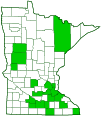Siberian cranesbill
(Geranium sibiricum)
Conservation • Description • Habitat • Ecology • Use • Distribution • Taxonomy
Conservation Status |
|
|||||||
| IUCN Red List | not listed |
|||||||
| NatureServe | NNA - Not applicable SNA - Not applicable |
|||||||
| Minnesota | not listed |
|||||||
Description |
||
Siberian cranesbill, also cvalled Siberian geranium, is a 1′ to 3′ tall, annual forb rises on many stems from a short, inconspicuous rhizome. The stems are ascending, many branched, and covered with soft, down-pointing hairs. The leaves are opposite, 1½″ to 2¾″ wide, and palmately divided into 3 to 7 deep lobes, cut almost to the base. The leaf margins are coarsely toothed or have secondary lobes. The lobe tips are pointed. The inflorescence is a single (sometimes a pair) of flowers on hairy, but not glandular, stalks. The cluster is at the end of a long stalk. The flowers are ⅓″ to ½″ (possibly ⅔″) wide with 5 petals and 5 sepals. The sepals have short, stiff bristles at their tips.The petals are lilac to white with violet markings and slightly notched at the tip. The petals are erect, not spreading. The fruit is a ½″ to ¾″ long, hairy capsule with a beak at the tip. The fruit is in the shape of a crane’s bill, giving this plant one of its common names, Carolina Cranesbill. |
||
Height |
||
1′ to 3′ |
||
Flower Color |
||
Lilac to white with violet markings |
||
Similar Species |
||
Bicknell’s cranesbill (Geranium bicknellii) leaves are divided into usually 5 deep lobes, cut almost to the base. The inflorescence is a cluster of 2 flowers at the end of a long stalk. The individual flowers are on two shorter individual flower stalks that are more than twice the length of the sepals. The fruit is ¾″ to 1″ long. Carolina cranesbill (Geranium carolinianum var. carolinianum) leaves are divided into usually 5 to 9 deeply-cut lobes. The inflorescence is tight a cluster of many flowers. The petals are pink with no markings. Meadow geranium (Geranium pratense) has no central stem, rather two basal leaves and a flowering stem with a single pair of opposite leaves. The leaf stalks and flower stalks are covered with sticky, glandular hairs. The inflorescence is a small cluster at the end of a long stalk. The flowers are large, 1″ to 1½″ wide. The flower petals are bright blue-violet, are not marked with darker lines, and are rounded, not notched, at the tips. It is an introduced species. It has been recorded only in St. Louis County. Robert’s geranium (Geranium robertianum) leaves are divided into usually 3 to 5 leaflets. The leaflets are cut all the way to the base, with at least the terminal leaflet on an evident leaflet stalk. It has been recorded only in St. Louis County. Wild geranium (Geranium maculatum) has no central stem, rather two basal leaves and a flowering stem with a single pair of opposite leaves. The inflorescence is a flat or round topped cluster of 1 to 6 flowers at the end of a long stalk. The flowers are large, 1″ to 1½″ wide. The flower petals are rose-purple, pale purple, violet-purple or, rarely, white, with darker fine lines radiating from the center of the flower. |
||
Habitat |
||
Roadsides |
||
Ecology |
||
Flowering |
||
August to September |
||
Pests and Diseases |
||
|
||
Use |
||
|
||
Distribution |
||||
|
Sources |
|||
| 2/19/2023 | ||||
Nativity |
||||
Native to Asia, eastern Europe, and Pakistan. Introduced. |
||||
Occurrence |
||||
|
||||
Taxonomy |
|||
| Kingdom | Plantae (green algae and land plants) | ||
| Subkingdom | Viridiplantae (green plants) | ||
| Infrakingdom | Streptophyta (land plants and green algae) | ||
| Superdivision | Embryophyta (land plants) | ||
| Division | Tracheophyta (vascular plants) | ||
| Subdivision | Spermatophytina (seed plants) | ||
| Class | Magnoliopsida (flowering plants) | ||
| Superorder | Rosanae | ||
Order |
Geraniales (geraniums, bridal wreaths, and allies) | ||
Family |
Geraniaceae (geranium) | ||
Genus |
Geranium (geraniums and cranesbills) | ||
| Subgenus | Geranium | ||
| Section | Geranium | ||
Subordinate Taxa |
|||
|
|||
Synonyms |
|||
|
|||
Common Names |
|||
Siberian cranesbill Siberian crane’s-bill Siberian geranium |
|||
Glossary
Axil
The upper angle where the leaf stalk meets the stem.
Glandular hairs
Hairs spread over aerial vegetation that secrete essential oils. The oils act to protect against herbivores and pathogens or, when on a flower part, attract pollinators. The hairs have a sticky or oily feel.
Node
The small swelling of the stem from which one or more leaves, branches, or buds originate.
Palmately divided
Similar to a hand. Having more than three lobes that radiate from a single point at the base of the leaf.
Sepal
An outer floral leaf, usually green but sometimes colored, at the base of a flower.
Visitor Photos |
|||||
Share your photo of this plant. |
|||||
| This button not working for you? Simply email us at info@MinnesotaSeasons.com. Attach one or more photos and, if you like, a caption. |
|||||
|
|||||
MinnesotaSeasons.com Photos |
|||||
|
|||||

Slideshows |
||

Visitor Videos |
|||
Share your video of this plant. |
|||
| This button not working for you? Simply email us at info@MinnesotaSeasons.com. Attach a video, a YouTube link, or a cloud storage link. |
|||
Other Videos |
|||

Visitor Sightings |
|||||
Report a sighting of this plant. |
|||||
| This button not working for you? Simply email us at info@MinnesotaSeasons.com. Be sure to include a location. |
|||||
|
|||||
MinnesotaSeasons.com Sightings |
|||||
|
|||||

|
Created: Last Updated: © MinnesotaSeasons.com. All rights reserved. |
